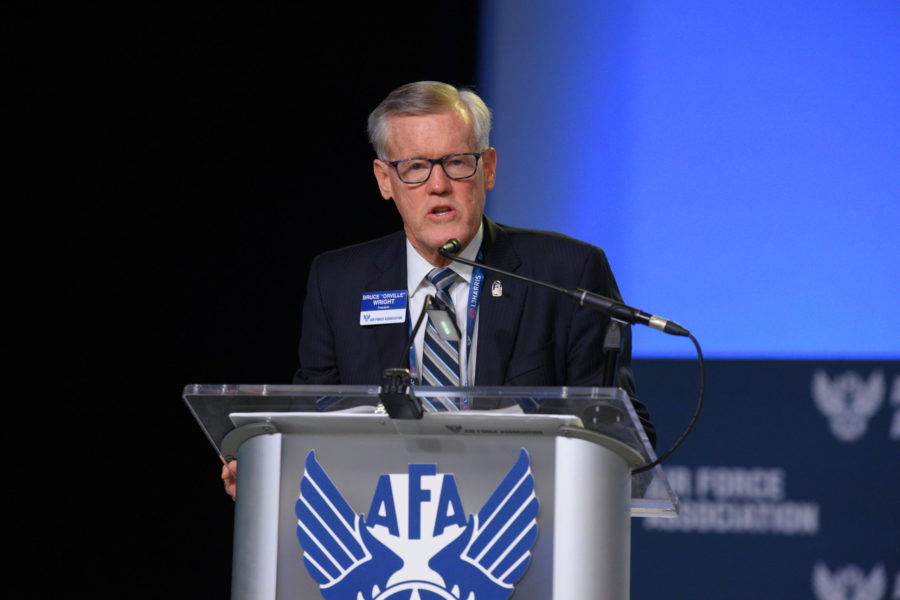Congressional leaders say they have made a significant breakthrough toward agreeing to a budget for fiscal year 2022—more than four months after the fiscal year began. But Air Force Association leaders are calling on lawmakers to break what has become a nearly-annual tradition of continuing resolutions to fund the Pentagon and other federal agencies.
“Our position is the CRs have got to go away,” AFA chairman and retired Chief Master Sergeant of the Air Force Gerald Murray said in a virtual press conference Feb. 10, detailing a letter sent by AFA leadership to Senate Majority Leader Chuck Schumer (D-N.Y.), Minority Leader Mitch McConnell (R-Ky.), Appropriations Committee chair Patrick Leahy (D-Vt.), and ranking member Richard Shelby (R-Ala.), urging them to pass a defense budget.
“We’ve got to get back into where there’s regular scheduled budgeting and then the passage of defense bills, because already that’s a six-month delay,” Murray added. “It’s short notice right now for how priorities will be set by both services, and then nothing is even started for next year. And so CRs cannot be the way and should not in any way be the way that we … prioritize defense. That’s kind of the bottom line to it.”
Murray’s comments come one day after appropriators in the House and Senate announced they had agreed to “a framework for fiscal year 2022 appropriations,” setting the stage for Congress to finally pass a full budget. Since Oct. 1, the government has been operating under a series of continuing resolutions, keeping funding levels frozen at the previous year’s level with only a few exceptions.
Pentagon officials have frequently bemoaned the effects of continuing resolutions, saying they delay new starts to programs, slow acquisitions, and keep money stuck in the wrong accounts. In a recent Congressional hearing, Air Force Chief of Staff Gen. Charles Q. Brown Jr. warned that a full-year CR, threatened by some in Congress, would be “shattering.”
Yet operating under CRs for at least part of the year has become the norm for the Defense Department in recent years—the department has started 12 of the last 13 fiscal years under a CR, with fiscal 2019 being the lone exception.
This cycle not only slows new programs, it also costs money. Murray cited Sen. Jack Reed (D-R.I.) in saying that a full-year CR costs the Pentagon $36 billion in buying power. Those losses are especially crucial given the badly-needed modernization efforts currently being undertaken by the Air Force, added AFA President retired Lt. Gen. Bruce “Orville” Wright.
“We have a geriatric Air Force, and it’s not just geriatric in [terms of] the age of B-52s, as we’re trying to upgrade them,” Wright said. “But, you know, there are capabilities out there that not only need to be upgraded, but [need to be replaced]. We need to move on, to Next Gen Air Dominance, and a system of systems approach that includes JADC2 and ABMS, to build an asymmetric capability to deter, and certainly to fight and win, against the pacing threats of the Chinese military.”
Both Wright and Murray also pointed to the Air Force’s push to modernize the air and land legs of the nuclear triad as efforts that cannot be delayed. Brown told Congress the Ground Based Strategic Deterrent’s initial operating capability could be pushed past 2029, the Long Range Standoff Weapon by over a year, and the conventional initial operating capability and nuclear certification of the B-21 up to a year if CRs persist.
“Clearly modernization and funding for GBSD and … to field the new bomber … are critically important—never more important,” Wright said, than at any point since he first put on a uniform more than 50 years ago.
But perhaps the biggest impact continued CRs could have is on the fledgling Space Force. Established just over two years ago, the Space Force has existed under a CR for roughly seven months out of its 25 in existence. Chief of Space Operations Gen. John W. “Jay” Raymond told the Congressional panel that continued CRs would impact the service’s ability to establish itself, and Murray agreed that a frequent cycle of CRs could cripple the Space Force.
“I don’t see the ability for the Space Force to be able to build [to] where and what it needs to if we’re going to be in a continuous … loop of CRs,” Murray said.
There is hope, though, added Wright.
“What I think I see is great growing bipartisan collaboration, in fact, to recognize the reality of the threat,” Wright said. “Our nation’s at great risk, and we can’t ignore that. The threat doesn’t allow us any longer to just try to keep old cars running.”
While Congressional leaders say they’ve agreed to the basics of a deal, there’s still likely to be one more CR before a budget passes. The current CR expires Feb. 18, and the House recently passed another that would extend that funding through March 11. Schumer, in a floor speech on Feb. 10, said the Senate would look to pass that bill next week. If approved, it would be the third continuing resolution since the fiscal year began on Oct. 1, 2021.

